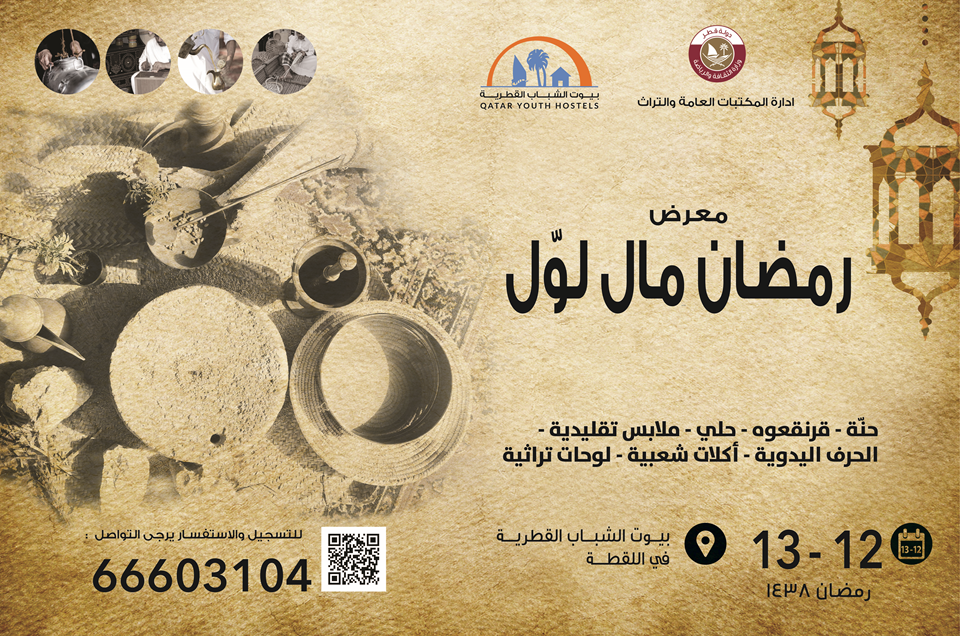
- On June 6, 2017
- In Uncategorized
- Tags
No Comments
In celebration of the Garangao Night in its premises on Ramadan 12th and 13th, The Qatar Youth Hostels to hold Ramadan Mal Lawal Exhibition
The Qatar Youth Hostels (QYH) Association, in participation with the Department of Public Libraries and Heritage, Ministry of Culture and Sports (MCS), is holding the Ramadan Mal Lawal Heritage Exhibition on Ramadan 12-13 at the QYH premises, located in Luqata area. The Exhibition manifests artefacts of the ancient Qatari Heritage and renders its visitors an integrated pictured and illustrated presentation of the ancient values and legacies to get them connected with the Qatari History and Heritage, which is abundant with recognizable old traditions, customs and crafts.
According to QYH Association, the Exhibition mainly focuses on traditional craftsmanship, most dominantly on the authentic Bedouin heritage Sadu (weaving craft). The weaving and spinning of wool has been originally a traditional craft that was prevalent in the desert, yet still exists to date, since it is mainly associated with the abundance of the relevant raw material of the wool of sheep, camels and goats, beside cotton.
Moreover, the Sadu craft has been long and still depending primarily on the efforts of women. It has not become extinct, unlike many other crafts that no longer exist owing to the change of people’s requirements in the post-oil era. Used for centuries and still used today, Sadu tools include e.g. a spindle, a loom and a machete, and its products involve Bedouin tents, porches, rice bags, clothing sacs, and colorful ornaments.
Gold, jewelry and precious stones are anchored crafts in Qatar and named after the families who used to practice them. Their tools included differently-sized hammers, anvils, rough and smooth flat-head files, and smelters for melting gold ore. The most prominent products were the bangles or anklets, earrings, bracelets, necklaces, head ornaments, e.g. Taset Al Saad, along with other ancient folklore ornaments.
The Exhibition also features the embroidery craft i.e. trimmings of male and female traditionally worn garments. It is an old trade in the region. The Darzi, the trimmer, manually trims the clothing with colored, gold and silver strings, called Naqda. A semi-automatic instrument, or recently an electric one, could be used for accelerated and skillful pieces of work.
Folklore clothing, an inherent craft, is also presented in the Exhibition. Women’s costumes have still been tailored, e.g. Daraa, Thawb, Bakhnak, Nashl, pants and gown, along with men’s garments e.g. shalhat, dakla and pants.
In addition, the plaster decoration, widespread in almost all old-style residences. Plaster, or Gypsum, was locally made and used to decorate the interior and exterior walls of houses, castles, palaces, towers and mosques, in lieu of clay, for its durability of the climatic and natural forces. Plaster, is also utilized to make molds with engraved geometric and abstract flora patterns that used to adorn many traditional residences in Qatar. Plaster censers, still popular for home decoration, were also created.
Since ancient times, the sea has had a protruding footprint in the everyday life of Qataris. This is well supported by the geographical location of the Country as a peninsula. Fishing is a deep-rooted craft practiced by the coastal population. It was such an important craft that it created a source of sustenance and nutrition long before the black gold era.
Creation and repair of fishing nets had different tools, e.g. Meseker and Hadra. People in the Gulf area, and particularly in Qatar, developed a fishing style using those two tools. Hadra, for instance, was made of local materials e.g. palm leaf and fiber ropes and used to catch different types of fish.
The art of Henna is exhibited, as well. It has been practiced by a pigmentary specialist, Khadabah, who hennas the bride’s palm and feet, in a process called Henna Dough Making. It uses flour to make a dough, formed as threads, made as beautiful geometric patterns and stuck in the palms and feet. Henna is then placed on the whole palms and feet to cover the pre-decorated dough.
Furthermore, folklore cuisine is strongly manifested in the exhibition. It involves the indigenous cuisine of many popular dishes e.g. Thareed, Harees, Harees Soup, Mehamer, Madrouba, Marquqa, Kabbab Al Nakhi, Balalait and Khanfrush.
At long last, the Exhibition also involves the celebrations of the Garangao Night, a traditional event that is aimed at the revival of the Qatari and Gulf Heritage and reminding the children, who are given treats and candies, of the folklore clothing, along with other activities.

